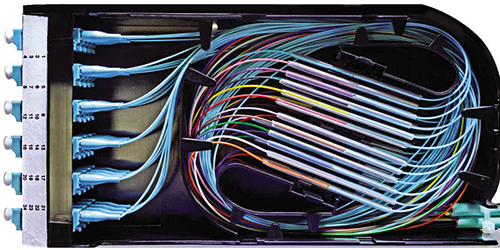To Splice or Not to Splice is Not the Only Question
Despite the growing popularity of pre-terminated fiber optic assemblies and the common practice of fiber field termination using no-epoxy, no-polish, no-crimp field-installable connectors such as Belden FiberExpress Brilliance Universal connectors, fusion splicing remains a widespread practice for connectorizing fiber in many applications.
 With a long heritage in harsh outside plant environments, fiber splicing has been a viable option for both joining and repairing fiber cable, as well as for using factory-polished pigtails that enable low-loss, reliable field-termination. As fiber deployment has become mainstream, splicing has naturally crossed from the OSP world into the enterprise and even the data center environment.
With a long heritage in harsh outside plant environments, fiber splicing has been a viable option for both joining and repairing fiber cable, as well as for using factory-polished pigtails that enable low-loss, reliable field-termination. As fiber deployment has become mainstream, splicing has naturally crossed from the OSP world into the enterprise and even the data center environment.
When choosing to splice or not to splice, the cost of labor, tooling, equipment, materials and training involved in fusion splicing versus other field-term or pre-term fiber should always be reviewed on a case-by-case basis. There are also some choices to be made once there is a definite decision to splice.
Weighing the Options
Fusion splicer tooling costs have been one of the biggest obstacles to a broad adoption of fusion splicing. In recent years, significant decreases in splicer prices, coupled with the proliferation of low-cost rental options, has accelerated the popularity of fusion splicing.
When it comes to investing in a fusion splicer, one consideration is whether to go with a single fusion splicer or a mass fusion splicer. Splicing up to 12-fibers in a single operation, mass fusion splicers offer the opportunity to significantly reduce termination labor by up to 75% with only a modest increase in tooling cost. Beyond reducing labor, mass fusion splicing provides further material savings by enabling migration from common indoor distribution cable with 900um fiber to cost-effective, smaller mini-distribution cable with 250um fiber.
Inside the data center and in the enterprise LAN, 12-fiber MPO connectors provide a convenient method to support higher 40G and 100G bandwidth and trunking of duplex protocols like 1G, 10G and Fibre Channel. With the use of MPOs previously limited by needing to predetermine lengths for pre-terminated MPO assemblies, mass fusion splicers now enable connectorizing MPOs for any length using factory-polished MPO pigtails.
Slack Storage and Protection Choices
Fusion splicing does have two special needs that need to be accommodated:
- Storage of protective heat shrink splice sleeves to protect the fragile joints
- Slack management for 250um, 900um or ribbon fiber to enable re-termination of damaged connectors
Traditionally addressed with larger more complex splicing solutions, Belden has taken a new approach to storing splice sleeves and managing slack for splicing applications. Our new FX UHD Splice Cassettes eliminates the need for complex patch panels by integrating splice and slack storage directly into the cassettes that mount into simpler, cost-effective patch panels, including mounting options for wall mount, rack mount and 0U cabinet space.
FX UHD Splice Cassettes provide the ultimate vehicle to take full advantage of new fusion splicing options while addressing the gamut of splicing requirements. They support all common splice protection sleeves with integrated slack management, including 900um to 900um 2.5mm OD, 900um to 250um 2.0mm OD and even oval ribbon sleeves. They also support single 900um pigtails and mass fusion LC/SC/ST pigtail kits, as well as mass fusion of MPO pigtails for today’s duplex protocols and 40G and 100G.
